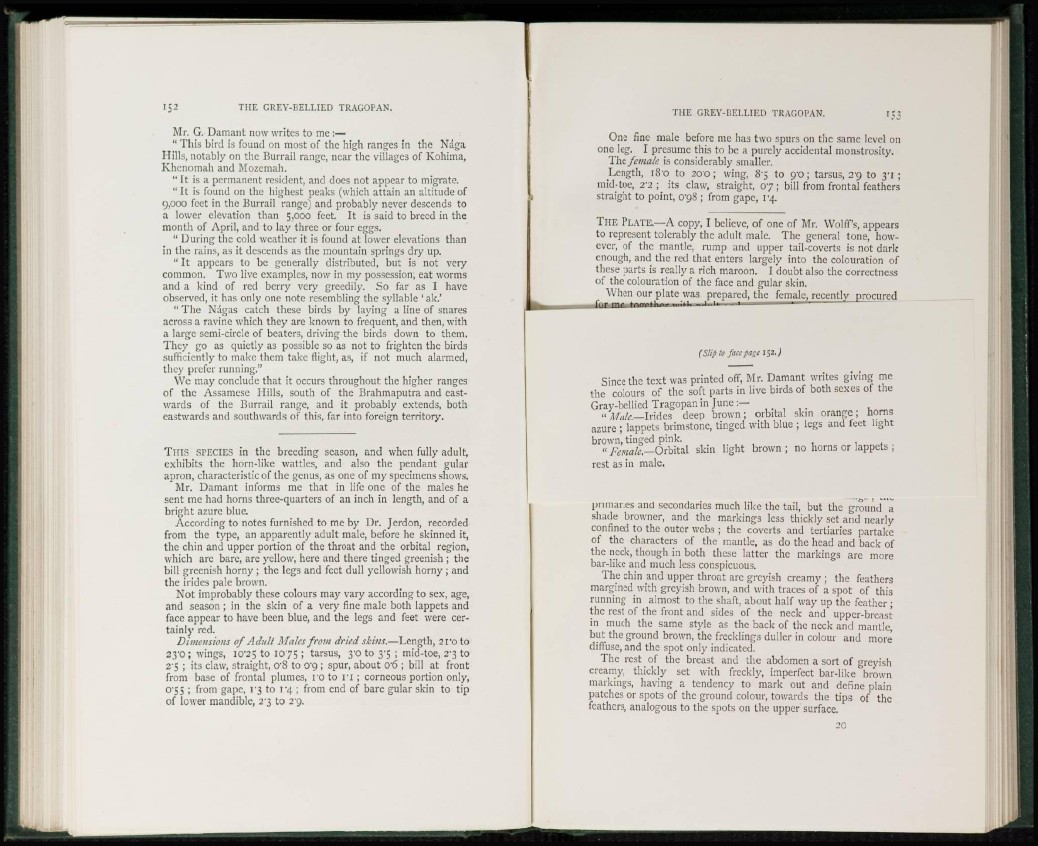
Mr. G. Damant now writes to me :—
" This bird is found on most of the high ranges in the Naga
Hills, notably on the Burrail range, near the villages of Kohima,
Khenomah and Mozemah.
" It is a permanent resident, and does not appear to migrate.
" It is found on the highest peaks (which attain an altitude of
9,000 feet in the Burrail range) and probably never descends to
a lower elevation than 5,000 feet. It is said to breed in the
month of April, and to lay three or four eggs.
" During the cold weather it is found at lower elevations than
in the rains, as it descends as the mountain springs dry up.
" It appears to be generally distributed, but is not very
common. Two live examples, now in my possession, eat worms
and a kind of red berry very greedily. So far as I have
observed, it has only one note resembling the syllable ' ak.'
" The Nagas catch these birds by laying a line of snares
across a ravine which they are known to frequent, and then, with
a large semi-circle of beaters, driving the birds down to them.
They go as quietly as possible so as not to frighten the birds
sufficiently to make them take flight, as, if not much alarmed,
they prefer running."
We may conclude that it occurs throughout the higher ranges
of the Assamese Hills, south of the Brahmaputra and eastwards
of the Burrail range, and it probably extends, both
eastwards and southwards of this, far into foreign territory.
THIS SPECIES in the breeding season, and when fully adult,
exhibits the horn-like wattles, and also the pendant gular
apron, characteristic of the genus, as one of my specimens shows.
Mr. Damant informs me that in life one of the males he
sent me had horns three-quarters of an inch in length, and of a
bright azure blue.
According to notes furnished to me by Dr. Jerdon, recorded
from the type, an apparently adult male, before he skinned it,
the chin and upper portion of the throat and the orbital region,
w7hich arc bare, are yellow, here and there tinged greenish ; the
bill greenish horny ; the legs and feet dull yellowish horny ; and
the irides pale brown.
Not improbably these colours may vary according to sex, age,
and season ; in the skin of a very fine male both lappets and
face appear to have been blue, and the legs and feet were certainly
red.
Dimensions of Adult Males front dried skins.—Length, 2i'o to
23-0; wings, io'25 to 1075 ; tarsus, 30 to 3'5 ; mid-toe, 2'3 to
2'5 ; its claw, straight, 0'8 to 0'9 ; spur, about 0'6 ; bill at front
from base of frontal plumes, 10 to r i ; corneous portion only,
0'55 ; from gape, I'3 to 14 ; from end of bare gular skin to tip
of lower mandible, 2'3 to 29.
One fine male before me has two spurs on the same level ^o n
one leg. I presume this to be a purely accidental monstrosity.
The female is considerably smaller.
Length, i8'o to 200 ; wing, 8-5 to 9'0; tarsus, 29 to 3-1 ;
mid-toe, 2'2 ; its claw, straight, 07; bill from frontal feathers
straight to point, 0-98 ; from gape, 14.
THE P L A T E . — A copy, I believe, of one of Mr. Wolff's, appears
to represent tolerably the adult male. The general tone, however,
of the mantle, rump and upper tail-coverts is not dark
enough, and the red that enters largely into the colouration of
these parts is really a rich maroon. I doubt also the correctness
of the colouration of the face and gular skin.
When our plate was prepared, the female, recently procured
(Slip to face page 152 J
Since the text was printed off, Mr. Damant writes giving me
the colours of the soft parts in live birds of both sexes of the
Gray-bellied Tragopan in June :—
"Male.—Irides deep brown; orbital skin orange; horns
azure ; lappets brimstone, tinged with blue ; legs and feet light
brown, tinged pink.
" Female.—Orbital skin light brown ; no horns or lappets ;
rest as in male.
primaries and secondaries much like the tail, but the ground a
shade browner, and the markings less thickly set and nearly
confined to the outer webs ; the coverts and tertiaries partake
of the characters of the mantle, as do the head and back of
the neck, though in both these latter the markings arc more
bar-like and much less conspicuous.
The chin and upper throat arc greyish creamy ; the feathers
margined with greyish brown, and with traces of a spot of this
running in almost to the shaft, about half way up the feather ;
the rest of the front and sides of the neck and upper-breast
in much the same style as the back of the neck and mantle,
but the ground brown, the frecklings duller in colour and more
diffuse, and the spot only indicated.
The rest of the breast and the abdomen a sort of greyish
creamy, thickly set with freckly, imperfect bar-like brown
markings, having a tendency to mark out and define plain
patches or spots of the ground colour, towards the tips of the
feathers, analogous to the spots on the upper surface.